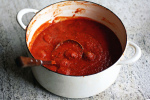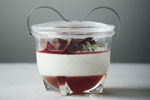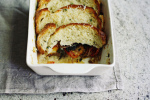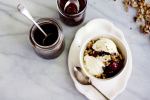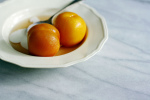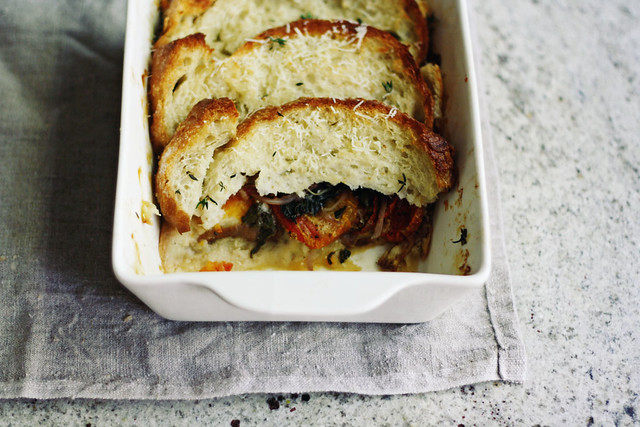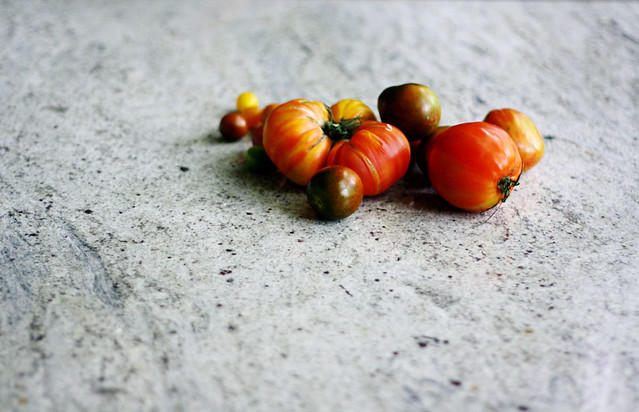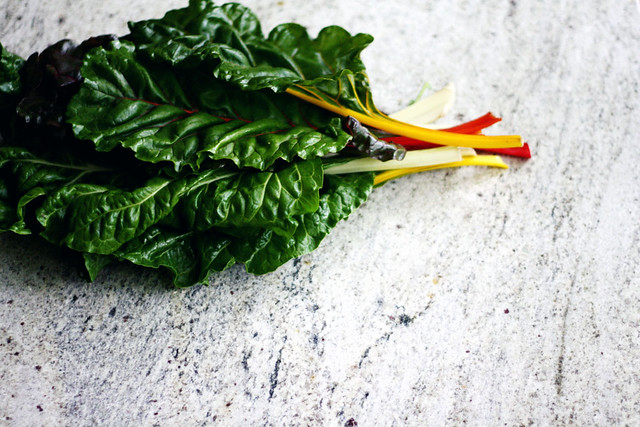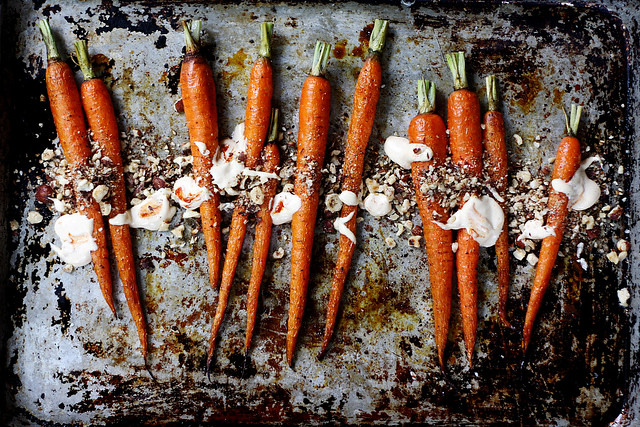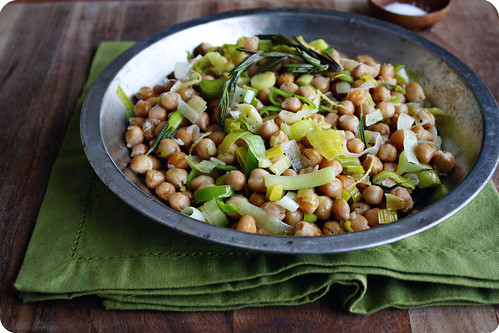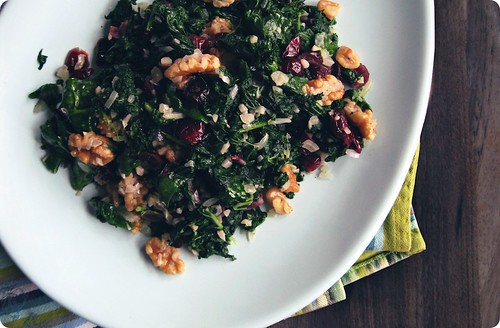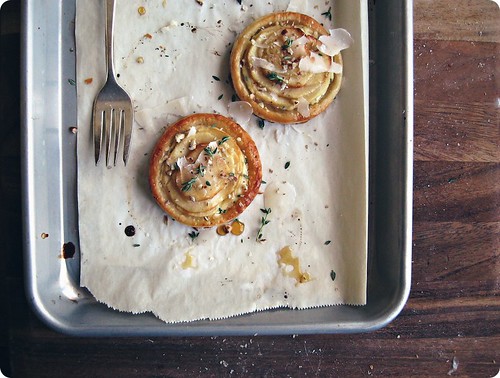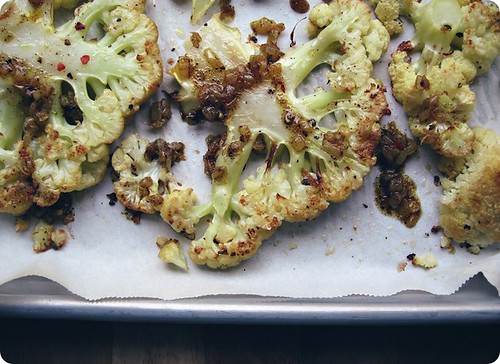Each on their own
 Friday, October 5, 2012 at 9:07AM
Friday, October 5, 2012 at 9:07AM I have a cardigan that's unmistakably ugly; the colour is drab and makes me look like I'm either coming down with a cold or getting over one. It was made for a tall man, which I am not, so the shoulders droop. On the left side, at my hip, above the pocket, there's a small hole, round and neat like you pushed a sharpened pencil through the wool. I've rolled the cuffs so many times that they're stretched out, and are beginning to ruffle at the edge. Still, the sweater is in my closet, because it is warm and comfy, and I like it. No matter its looks.
I feel very much the same way about panade. I'm a sucker for substance.
A panade is like a savoury bread pudding, or the best parts of French onion soup and a gratin packed together in a casserole. There's bread and cheese and vegetables stacked up on top of each other, baked until the bottom goes lush and the top is crusted golden. A collection of humble ingredients — a fine use of those past their prime, actually — and one that lands up at an end far more auspicious then its start. It's made with stock rather than a custard to bind the layers, so even though rich and filling, the flavour of is clearer. There's acidity from the wine and tomatoes, the sharpness of sturdy greens, the pronounced, aromatic nuttiness of Gruyère; all together, yet each on their own.
You may be familiar with the recipe for chard and onion panade from the Zuni Café cookbook; if not, you'll find it has a deservedly faithful following. This version adds tomatoes, and their inclusion made it perfect for our start to October, as the trees are starting their turn to technicolour but the days are warm enough that there are (crazy) folks wearing shorts and no coats. This panade is what we had one night when, if not for dinner, I was ready for the blanket we keep tucked by the couch. Hot and bubbling from the oven, we spooned our meal sloppily onto plates — though the crust shattered with an impressive shower of crumbs, underneath there were puddles of broth, and the oozing slip of melted cheese. The vegetables were supple but retained a messy integrity, if not their colour. We had fried eggs on top.
It seems a counterintuitive to take vibrant tomatoes, minutes away from the end of their season, pile them with bouncily green bunches of rainbow chard and lacinato kale, and cook the lot of it to a muted sog, and yet, it makes absolute sense. The result is pretty much exactly what's going on outside right now, a season that blazes but feels cozy; one that's equal parts shining sky and colours turned up to eleven, as it is grey clouds and dim evenings, with the lights turned on early.
Floppy sweaters and panades, both fit me fine.
Tomato, greens and Gruyère panade
Adapted from Food and Wine. With two children at the table, I didn't let the panade bake too long uncovered, since when the crust goes terminally crunchy it can be difficult for small mouths to manage. If that's not a concern, feel free to fully blitz the top until crispy all over.
Ingredients
4 tablespoons unsalted butter, divided, plus more for the pan
5 pounds mixed sturdy greens, such as chards and kales, stemmed
2 tablespoons extra-virgin olive oil
2 large onions, thinly sliced
1 tablespoon chopped fresh thyme
1 small garlic clove, minced
1 cup dry white wine
Salt and freshly ground black pepper
3 cups chicken stock, preferably homemade
One 1-pound, day-old peasant loaf, sliced 1/2-inch thick
3 pounds beefsteak tomatoes, sliced 1/2-inch thick, see note
8 ounces Gruyère cheese, grated, plus extra for garnish
Butter a 10x15-inch baking dish and set aside. Preheat an oven to 400°F (200°C), with a rack in the upper third.
In a large, wide pot of boiling water, cook the greens for 2 minutes, then drain into a colander and run under cold water. Once cool enough to handle, squeeze out the excess water. Chop coarsely and set aside.
In the same pot, melt 2 tablespoons butter with the olive oil over medium-low heat. Add the onions and thyme and cook, stirring occasionally until the onions have softened, around 12 minutes. Stir in the garlic and cook for 2 minutes more. Raise the head to medium-high and pour in the wine; simmer until the wine has reduced to 1/4 cup, around 5 minutes. Stir in the greens and season with salt and pepper.
In a small saucepan, bring the stock to a simmer. Line the bottom of the prepared baking dish with one-third of the bread slices, overlapping and trimming the bread to fit. Layer half the tomatoes on top, and season with salt and pepper. Spread half the greens mixture on next, then half of the cheese. Repeat layers with the remaining ingredients, gently pressing down as you build, ending with the bread. Carefully pour the stock over the casserole and press down again, this time using a spatula. Melt the remaining 2 tablespoons of butter and brush over all.
Cover the dish with foil and bake in the preheated oven for 1 hour. Remove the foil and bake for 10-15 minutes more, until the top is browned and crisp. Remove from the oven and allow the casserole to rest for 10 minutes before serving. At the table, sprinkle some reserved cheese on top, if desired.
Serves 8, nicely with a salad and/or a fried egg alongside.
Note:
- I used a mix of tomatoes we had hanging about; if you don't have beefsteaks, semi-roasted Romas would be particularly fine, as done here.
- Fontina is a good switch for the Gruyère.
*******
From UPPERCASE magazine, issue #15: cooking science and a recipe for roasted carrots with rough dukkah, and one for harissa mayonnaise.
I am especially proud to be a contributor to UPPERCASE magazine, and I'm heartily thankful for support shown for my stories over there. To show that appreciation, I'd like to give away two copies of the latest, jaw-droppingly gorgeous issue! It even has a super-nifty embossed cover — you'll want to see this one in person. Simply leave a comment here if you'd like to be considered. (Please provide a way to contact you, either through your own website or email address. If concerned about privacy on the latter, the information is only visible to me when entered in the contact email field of the comment form. It will not be made public.)
Entries will be accepted until at 11:59 p.m. on Friday, October 12, 2012.
My continued thanks and best of luck! xo.



